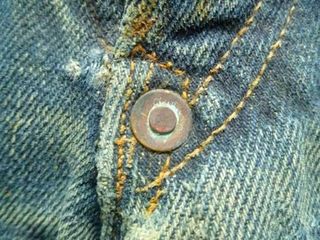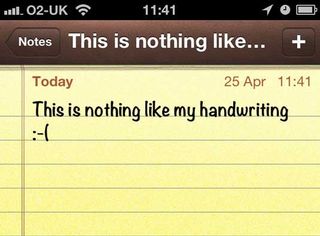Design jargon explained: Skeuomorphism
Apple's been accused of overdoing skeuomorphism in its UI design, but what exactly is it? Robb Green of creative agency Sift Digital explains all...
There's been a lot of talk about skeuomorphism lately - especially its use in Apple's iOS UI design. But what exactly is it?
A skeuomorph is something that retains anachronistic design elements which were integral to the original but are no longer necessary. Want an example? You're probably wearing one - take a look at your jeans...
Words: Robb Green
Rivet-ing design
When was the last time you thought about your jeans? Not just in a 'what trousers shall I wear today' sense - when did you last really consider their construction and the historical reasons for their appearance?
You probably never have. They're jeans, there's not much to think about. But if you suddenly acquired a pair that didn't have any rivets, you would think about it - they'd look a bit weird, maybe unfinished.

Yet the rivets on your jeans serve no purpose whatsoever - they're just an aesthetic hangover from a time when denim was too thick to be held together just be stitching, a dead-end ornament intended purely to make you feel comfortable.
Rivets in the context of jeans are a skeuomorph. They're unnecessary, but they make you feel good.
Get the Creative Bloq Newsletter
Daily design news, reviews, how-tos and more, as picked by the editors.
Skeuomorphs are everywhere
In other words, a skeuomorph is a design element in a recreated object that was structurally important in the original but no longer necessary. And once you know what they are, you'll suddenly notice that they're everywhere!
The plastic dashboard of your car is probably textured to look like leather (if it's dark and you squint). You probably own at least one jacket that has cuffs with buttons that don't undo. And nearly everybody has been stuck to a leatherette sofa on a hot day.
All these things are functionally irrelevant - they exist just because we're used to them, and that's enough of a reason (even if, in some cases, the recreation is objectively inferior to the original).
Digital design
Historically, skeuomorphism has been of vital importance to digital design. If you've never seen a computer before, the idea of interacting with one is incredibly daunting; creating familiarity by referencing real life is an invaluable way of closing the credibility gap between fairly abstract concepts and literal interaction.
Instantly sending bytes of data to someone across a global system of interconnected computer networks is hard to get your head round - and clicking on a picture of an envelope to send an email makes a lot more sense.
Aesthetic choice
We're a long way into the computer age now though, and so these days skeuomorphism is more often a purely aesthetic choice rather than an attempt to actually help people.
Apple is especially keen on skeuomorphism. Take the Notes app on an iPhone or iPad; it has a background designed to look like paper, and uses a typeface that looks a bit (but not enough) like handwriting.

Voice Memos has a picture of a microphone and an old-fashioned VU meter - it looks nice, but it's a bit confusing because you need to speak into the phone's actual microphone, not the picture, and it's hard to see the VU meter if you're close enough to the phone to overload it.

So if analogue recreation isn’t the way forward, what is?
Microsoft's Metro
Unusually, Microsoft might have the answer - its new Metro design language (have a look at Windows 8, Windows Phone or the Xbox 360 OS) offers a pioneering take on interface design that deliberately avoids referencing real-world objects and interactions in favour of blocks of flat colour and simple, unornamented text.
Avoiding skeuomorphs also frees the interface from ‘traditional’ interactions – swiping, sliding and dragging works much more intuitively on a Windows phone than an iPhone, where you’re just stabbing at pretend buttons.

Metaphysically troubling
Humans are a conventional species though. Until we’re genuinely technology-native, we need references to reality to help us engage with the more metaphysically troubling aspects of the internet.
Even Windows 8 doesn’t manage to entirely step away from convention – it still uses basket icons for shopping and a little envelope for email. But those concessions aren’t enough to prevent it being a disorienting experience for less tech-savvy users: for those audiences, digital needs to be grounded in physical reality.
Future trends
The move away from skeuomorphism will happen, but it’ll be a process of evolution. Bold statements like Windows 8 certainly help make the rest of the design community aware of the possibilities, but good design is (broadly) about removing the need to think, and a whole new design language, no matter how well thought out, will always cause more problems than it solves.
So, in summary, skeuomorphism doesn’t kill people, designers do; just like Comic Sans it has its place. And as designers, it’s up to us to make sure that place isn’t a neo-Tudor bungalow with pretend beams and an electric ‘fire’.
Robb Green is creative director at Sift Digital, a user-centred digital agency specialising in engagement.

Thank you for reading 5 articles this month* Join now for unlimited access
Enjoy your first month for just £1 / $1 / €1
*Read 5 free articles per month without a subscription

Join now for unlimited access
Try first month for just £1 / $1 / €1
The Creative Bloq team is made up of a group of design fans, and has changed and evolved since Creative Bloq began back in 2012. The current website team consists of eight full-time members of staff: Editor Georgia Coggan, Deputy Editor Rosie Hilder, Ecommerce Editor Beren Neale, Senior News Editor Daniel Piper, Editor, Digital Art and 3D Ian Dean, Tech Reviews Editor Erlingur Einarsson and Ecommerce Writer Beth Nicholls and Staff Writer Natalie Fear, as well as a roster of freelancers from around the world. The 3D World and ImagineFX magazine teams also pitch in, ensuring that content from 3D World and ImagineFX is represented on Creative Bloq.
